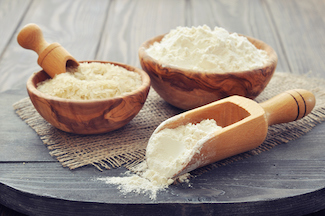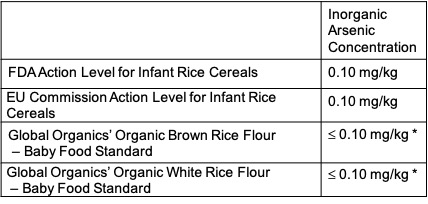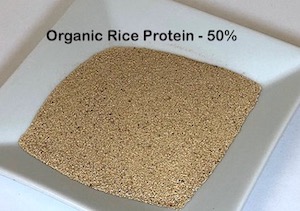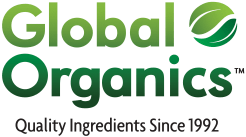6 Things to Know About Organic Rice Flour and Rice Protein
12.22.2020 | Author: Global Organics | Category: News
Global Organics recently introduced rice flour and rice protein to our portfolio of organic, plant-based ingredients. Our supply partner has worked very hard for years to build a sustainable project – one that fits perfectly with our beliefs about protecting the environment and treating farmers well. They are actively engaged in projects that slow climate change and regenerate natural resources; they’ve planted over 40,000 trees and have installed solar lighting. They also have extensive social and economic programs that support farmers and their families including children’s computer learning centers, women’s empowerment programs, and paying fair prices for crops. These are important things to know when you are looking for an ingredient that aligns with your environmental and ethical brand philosophy.
With that said, Alex Puglia, our category development manager for rice, graciously provided answers to some common questions we get about rice flour and protein.
Organic Rice Flour

Q: Is organic rice flour good for gluten-free baked goods?
A: Absolutely yes! Rice is a gluten-free grain. Rice is typically referred to as “hypoallergenic” meaning that there is a low risk of an allergic reaction. Many food formulators turn to rice when they are creating foods for babies and toddlers or for adults with gluten intolerance or sensitivity. Gluten-free flour blends often work best in baked goods.
Q: Are rice flour and rice starch the same thing?
A: Rice flour is essentially ground up rice grains and is made by a milling and sieving process to obtain a powder. It is purely a mechanical process. If the bran and the germ of the rice is not removed then the milling process results in brown rice flour, a whole grain flour. Rice starch, on the other hand, is made by breaking down milled rice using an alkali to slowly dissolve the rice protein and release the starch. While rice flour is used as a gluten-free flour for noodles, cereals or baking, rice starch is primarily used as a thickener.
Q: Rice flour is often used as an ingredient in infant and toddler foods where there is concern about arsenic. What level of arsenic is present in your rice flour?
A: First let me give you some information on arsenic in general. Arsenic is a naturally occurring compound that can be found in the environment, typically in soil and ground water as rocks containing arsenic minerals may erode overtime. Environmental arsenic can also come from mining or industrial activity resulting in soil and water contamination.
Arsenic can be divided into 2 categories, organic arsenic and inorganic arsenic. Organic arsenic is harmless as it is molecularly linked to organic matter (carbon); fish and shellfish are considered to be high in organic arsenic. On the other hand, inorganic arsenic is highly toxic; it is present as a single atom that is not linked to any organic matter.
While inorganic arsenic may be present at low levels in many cereal grains and fruits, it can be present at higher levels in rice. Why rice? Rice grows in flooded paddies where the water can harbor inorganic arsenic compounds that can be quickly and easily absorbed into the growing rice plant. Hence rice and products derived from rice (such as rice flour, rice syrups) can contain high level of inorganic arsenic. This is a problem for the entire rice farming industry, including rice grown under Organic Certified standards since the source of arsenic may be from natural ground erosion.
Global Organics takes this issue very seriously. For several years we have been looking to add organic rice-based products to our portfolio, searching for the right source and supplier. Our new supply partner is advantageously located in India, in the foothills of the Himalayas where mountain rain provides uncontaminated water to flood the rice fields, versus downstream rivers or wells. This is one of the best practices to limit the rice plants’ exposure to arsenic as rivers and wells can easily collect contaminated ground water.
In addition, for the past 12 years our supply partner has been monitoring and collecting data on arsenic occurrence in their rice farms and crops. The data collected has allowed them to track and to “geotag” fields that produce rice with lower levels of arsenic.
On the regulatory side, the FDA has finally published a safe level for rice cereal products intended for infants. This regulation is aligned with the levels set by the European Commission regulation 1881/ 2006. The concentration limit of inorganic arsenic in infant rice cereals is 100 μg/kg (100 ppb) or 0.1 mg/kg and applies to all types of infant rice-based cereals (e.g., white rice, brown rice, organically grown, and conventionally grown).
Our “Baby Food Standard” Organic Rice Flour meets the FDA and European low requirements for arsenic and can be used for any baby food application. The table below shows the inorganic arsenic level in our “Baby Food Standard” Organic Rice Flour compared to US and EU guidance.

*Complies “as is” with the FDA’s action level and EU guidance for inorganic arsenic in infant rice cereals
Organic Rice Protein

Q: What does it mean when you say rice protein 50%?
A: 100 grams of rice protein provides about 50 grams of protein, hence the 50%. Our organic rice protein powder is a by-product of making rice syrup. Processing rice to make syrup uses the starch component of the rice and leaves behind a concentrated protein for use in food applications.
Q: What kinds of foods use rice protein?
A: Rice protein (a plant protein) can be used in just about any food or beverage but it is primarily used by food brands that need a non-dairy protein source – either because they are making vegan products or are avoiding allergens. The ability to make a gluten-free claim is also dependent on using non-allergenic ingredients such as rice. All kinds of bars use rice protein - energy, protein, nutritional and snack bars. Protein drink mixes, supplement powders, beverages and cookies are also incorporating rice protein. Formulators most often use a blend of different plant protein sources.
Q: How do the plant-based proteins, rice and pea, compare?
A: Neither rice protein nor pea protein are complete proteins. A complete protein contains the nine amino acids, which our bodies can’t make (essential amino acids), and also provides them in adequate amounts. Rice protein is low in the amino acid lysine while pea protein is low in methionine and cysteine. When you are formulating with plant-based proteins, if you combine rice and pea proteins, you’ll get all nine essential amino acids in adequate amounts.
If you have other questions about rice flour and/or rice protein please contact your Global Organics Account Manager or email info@global-organics.com.


